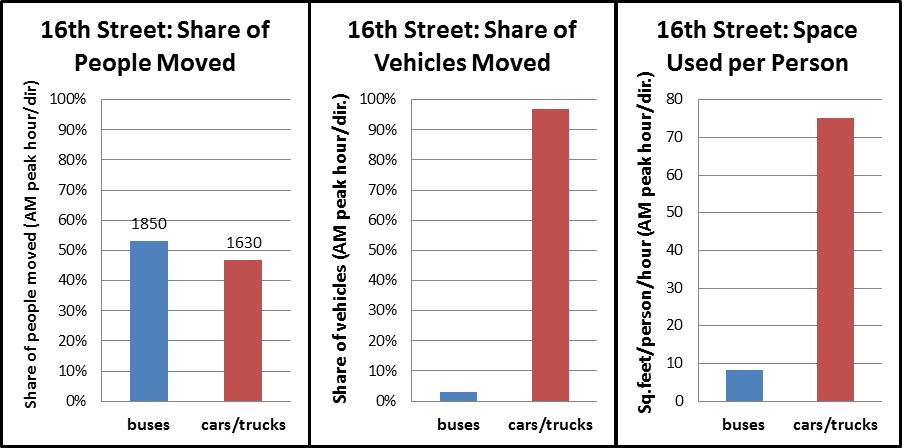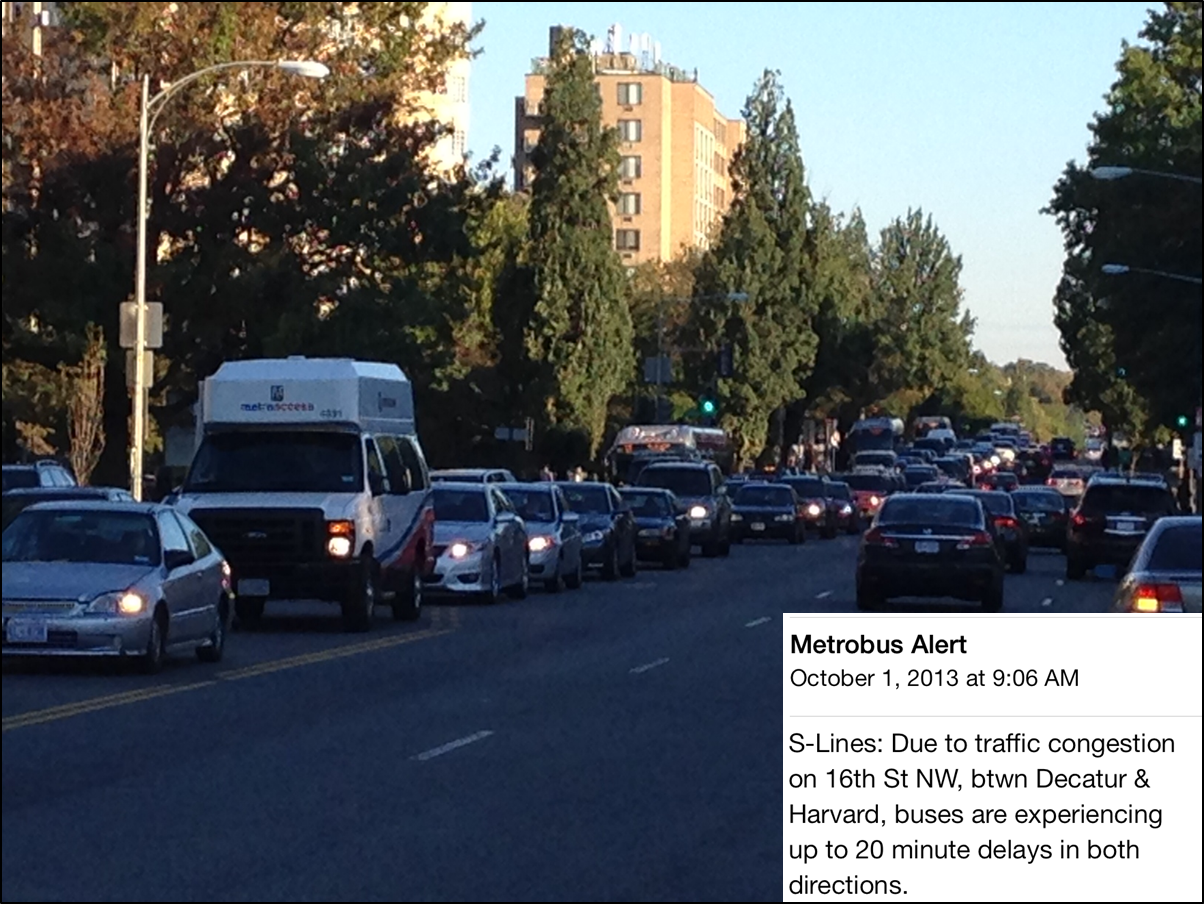Metrobus Carries the Load on 16th Street
During the morning rush hour, Metrobus carries 50% of all of the people traveling on 16th Street NW towards downtown DC, despite using just 3% of the vehicles. However, it still gets stuck in traffic.
It will come as no surprise to regular riders of the Metrobus S1,2,4 (PDF), or MetroExtra S9 (PDF), but ridership has grown tremendously in recent years on 16th Street, from just over 16,000 riders per weekday in 2008 to about 20,500 this year. To keep pace, Metro has added lots of new service, most notably the S9 limited stop service in 2009.
In fact, Metro has added so much rush hour service on lower 16th Street that buses headed towards downtown DC now operate more frequently than any transit service in the region, including Metrorail, with buses arriving an average of nearly every 90 seconds.
And these buses move a lot of people. A recent analysis* found that at the maximum load point, at rush hour into downtown DC, Metrobus services combine to carry about half all the people through the corridor with just three percent of the vehicles and using only eight square feet of available street space per person. These statistics are all the more impressive considering that buses currently have no priority over cars to improve travel times and reliability, leaving riders stuck in traffic.
By allocating roadway space on 16th Street based on the highest capacity and most efficient modes, dedicated bus lanes could allow bus speeds to increase, improving the travel times for riders. That could attract new riders, further increasing transit mode shares in heavily traveled corridors like 16th Street.
Fortunately, Metro is working with the District Department of Transportation (DDOT) to develop a new transit signal priority system for 16th Street that will help buses communicate with traffic signals and improve reliability and travel times. Metro will also work with DDOT to investigate the potential for exclusive bus lanes through the development of Metro 2025.
You can also provide your comment on exclusive transit lanes and other priorities through the District’s Move DC Plan, which will map out surface transit improvements like these as a part of a long range transportation plan for the city.
Cross-posted at Greater Greater Washington.
*NOTES: Bus (average weekday) ridership data from WMATA, March-June 2013; Hourly traffic volumes from Transportation Planning Board’s (TPB) Regional Transportation Data Clearinghouse, August 2011; Vehicle occupancy data taken from 2007-08 TPB Household Travel Survey.




Last night, there were zero buses in a 20 minute period. Zero. Hardly the 90 second frequency WMATA claims. That was a backup due to a motorcade at 16th and K, which begs all sorts of other questions, but mostly cries out for a way for buses to leapfrog the cars – that would be a dedicated, SEPARATED lane.
And while “all the demand” might be north of U, that means that it it virtually IMPOSSIBLE to get a bus going southbound in the morning from anywhere south of U. That’s crazy. Buses were coming every 90-120 seconds…but NONE OF THEM WERE STOPPING BECAUSE THEY WERE FULL. It took THIRTY MINUTES for a single bus to stop at 16th and S. That is totally unacceptable. I pay taxes in DC and yet I can’t get on a bus in my own city because they’re too full of Marylanders. This is madness.
In this case, it doesn’t matter what the land use is around 16th – it is an existing commuter and transit corridor that is desperate for capacity and priority improvements. That means, for SURE, dedicated lanes along most of the entire route. And more buses. And larger buses. And probably a higher capacity mode altogether.
The best solution is to take commuters off the road entirely. Really, there needs to be a metro line. One could even bring a metro stop to the new Walter Reed redevelopment. Go through downtown, and back out into Maryland through Northeast.
But that’s big money, even if this city does desperately need much, much higher transit capacity.
What DC needs is what is planned: a streetcar system that 95% serves DC residents. And by that I mean it is not commuter rail like Metro, filling up in VA and MD with those folks and then having no room for DC folks trying to get around. Likewise with the buses, which as MetroDerp points out, are filled with MD folks by the time they reach parts of DC.
As someone who rides the bus on 16th, I think rush hour bus-only lanes are needed the full length of 16th, but certainly between Newton and H Streets NW. Additionally, the buses should be equipped with cameras on the front to capture images of cars in the bus-only lanes as is done in San Francisco. [Relatedly, evening rush hour (no parking) should be pushed a half hour later to 4:30-7pm regardless of whether bus-only lanes are instituted.]
If 50+% of the people being moved along 16th St do so by bus, certainly we can allocate exclusive access to 33-50% of the space to them. Quicker and more fluid moving buses attracts more riders from their single occupancy vehicle which means more space for those drivers who have to drive and for whom transit is not a reasonable option. Everyone wins!
@MetroDerp We appreciate your comments. I’d point out that WMATA cannot control events such as police activity or Presidential motorcades, though we do the best we can to communicate these events to riders as they happen.
Metro’s ability to add capacity to 16th Street through articulated buses is limited by a lack of space to maintain them at the Northern Garage (built in 1907), where the S-Line buses are housed. While newer garages do have articulated bus capacity available, they are far from the 16th Street corridor, so it would be very costly to operate due to excessive “deadheading”, when the bus moves to and from its designated garage. Metro has been working on potential options (PDF) for a number of years, but have not yet found a suitable replacement for Northern. If Metro can resolve the garage capacity limitations in the future, there may be opportunities to add more articulated buses to 16th Street.
As I noted above, although the potential implementation of bus lanes will require further detailed study with DDOT, the city’s draft transportation plan (PDF) does call for dedicated lanes for transit along 16th Street. If you support this and other transit proposals within the District, please tell DDOT through the Move DC public involvement process .
That’s fair. It was just one more example of how if not the usual bad service it will be bad for other reasons altogether. And bus lanes would still enable far faster recovery of a good service.
Random question: is there a reason DC wouldn’t consider something like double-decker buses? There don’t seem to be many low-hanging obstacles to them, and they’d essentially double capacity.
@MetroDerp
WMATA would not consider double-decker buses because of the height restrictions in the older bus garages where the buses would have to be maintained. Also, on some routes there would be height restrictions in terminal facilities such as at Friendship Heights and traveling underneath bridges.